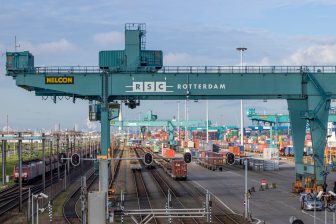
Big changes ahead for railway rolling stock identification
An international registry for easier rolling stock identification may be up and running before the end of the year. This public registry would assign a Unique Rail Vehicle Identification System (URVIS) identifier, a unique 16-digit number, to every railway rolling stock registered item, simplifying rolling stock management and financing.
Equipping rolling stock with a URVIS number is a requirement of the Luxembourg Rail Protocol (LRP), which is expected to be activated before the end of 2023. One of the most vocal organisations for the adoption and implementation of the LRP is the Rail Working Group (RWG), a Swiss-based non-profit association. RailFreight.com had a chat with Howard Rosen, chairman of the RWG, about the impact that an international registry of this kind can have on the rail industry.

What are the features of URVIS?
As Rosen claimed, the introduction of URVIS would allow for the creation of a global system to uniquely identify all rolling stock, which currently does not exist. This is a precondition for registering security interests, for mortgages or leases, on rolling stock in the international register. This system “will reduce risks for private sector lenders and lessors providing finance for the rail sector, in turn lowering financing costs for the rail industry”.
Rosen explains that, currently, manufacturer serial numbers differ between producers in composition, security, and style. Moreover, they may be repeated for different models or recycled just for one manufacturer. Current running numbers on rolling stock can therefore change and will vary in different parts of the world.
The URVIS number, on the other hand, will be unique, unchangeable, and the same for all types of equipment regardless of manufacturer or location. The new identification number will supplement, and not replace, the existing manufacturer and running numbers. Signing up in the international register will remain on a voluntary basis. However, Rosen pointed out that this registry may be significantly advantageous for the seamless cross-border operation of rolling stock worldwide.
URVIS will be more beneficial for rail freight companies
As Rosen explained, having an international registry operating 24/7 online and showing security interests on rolling stock will reduce investment risks and simplify the financing of all types of railway equipment. This would be especially true for companies dealing with rail freight rolling stock. The rail freight industry has a much larger private sector engagement compared to the passenger industry, where the presence of national governments is stronger. Securing funds from private lessors and banks can be more complicated than drawing on public finance, although public funds are not always available. Implementing URVIS and the international registry would reduce the financial risks of investing in railway rolling stock because its management would be easier.
The LRP and URVIS would also make it possible to always track in real-time the location and utilisation of the rolling stock. Consequently, rolling stock maintenance would also benefit from the implementation of the system. Rosen pointed out that having a permanent unique identifier would allow for better maintenance predictability. For example, instead of timing maintenance checks according to the age of the rolling stock, it would be possible to schedule them according to its state and condition. As Rosen mentioned, a URVIS number can be added to existing rolling stock as well.
How will URVIS work?
An interested party wishing to register a security interest at the international registry will need to apply for a URVIS number, against which the security interest is registered. The registry will allocate the URVIS number and once allocated, it will never be re-used. The 16-digit URVIS number can be obtained either from the registrar or a company or agency authorised by the registrar. Once allocated to an item, the URVIS number must be permanently affixed to that item and may not be affixed to or associated with any other item.
The system for marking the rolling stock has now been set out in the Model Rules on the Permanent Identification of Railway Rolling Stock (PIRRS), just adopted by the Inland Transport Committee (ITC) of the United Nations Economic Commission for Europe (UNECE) on 24 February. The Model Rules stipulate that the URVIS number is to be printed or engraved on a plate that will be permanently affixed on the rolling stock, preferably close to other identification or running numbers. The Model Rules are voluntary but are expected to be adopted gradually by the rail industry as it finances rolling stock, according to Rosen.
There has to be a minimum of two plates, one on each side of the item. The plate should be at least 15cm x 10cm in dimensions and built with materials resistant to weather conditions and maintenance procedures. It is recommended that the URVIS number be imprinted or engraved in black or grey on a silver background on the marker. It must be readable and protected from possible damage and if the marker is damaged, the keeper of the item has 21 days to fix it.
The Luxembourg Rail Protocol
The LRP is a global treaty that extends the benefits of the Cape Town Convention, held in 2001, to the rail industry. The Cape Town Convention, effective since 2006, is intended to standardize finance transactions involving movable assets. The LRP provides for an international registry where “the security interests of banks and lessors will be registered against the URVIS identifier issued by the registry”, as RWG explained. Recently Spain ratified the LRP opening the way for the “technical work needed to establish the international registry”, explained the RWG.




